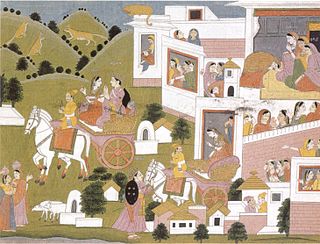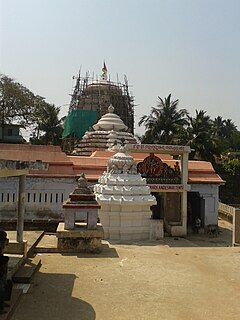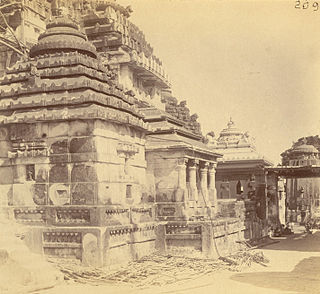
Jagannath literally means "Lord of the Universe" and is a deity worshipped in regional traditions of Hinduism and Buddhism in India and Bangladesh. Jagannath is considered a form of Vishnu. He is a part of a triad along with his brother Balabhadra and sister Subhadra. To most Vaishnava Hindus, Jagannath is an abstract representation of Krishna; to some Shaiva and Shakta Hindus, he is a symmetry-filled tantric representation of Bhairava; to some Buddhists, he is symbolism for Buddha in the Buddha-Sangha-Dhamma triad; to some Jains, his name and his festive rituals are derived from Jeenanath of Jainism tradition.

Ratha Jatra is a Hindu festival associated with Lord Jagannath held at Puri in the state of Odisha, India. It is the oldest Ratha Jatra taking place in India and the World, whose descriptions can be found in Brahma Purana, Padma Purana, and Skanda Purana and Kapila Samhita.
Tirtha is a Sanskrit word that means "crossing place, ford", and refers to any place, text or person that is holy. It particularly refers to pilgrimage sites and holy places in Hinduism as well as Jainism.
Prabhas Patan, also known as Somnath Patan or Prabhas Ksheta, historically named Dev Patan, is a town situated near Veraval, Gir Somnath district in Saurashtra region of Gujarat, India. It is located about 7 km. from Veraval. Somnath temple, a place of pilgrimage due to its importance as Jyotirlinga site dedicated to Shiva, is located here.

The Govardhana matha is a monastery located in the city of Puri in Odisha state (India). It is associated with the Jagannath temple and is one of the four cardinal mathas founded by Adi Shankara in the 8th century CE.

The Shree Jagannath Temple of Puri is an important Hindu temple dedicated to Lord Jagannath, a form of lord Maha Vishnu, located on the eastern coast of India, at Puri in the state of Odisha. The temple is an important pilgrimage destination The present temple was rebuilt from the 10th century onwards, on the site of an earlier temple, and begun by King Anantavarman Chodaganga Deva, first of the Eastern Ganga dynasty.
The Samavedis are an Indian community, originating from a group of classical musicians and dancers. They are Nayaks and Gayakas, believed to have been originated from Odisha, who live in 12 villages around the Nirmal Sarovar Vasai, earlier called Shurparak.

Yātrā, in Hinduism and other Indian religions, generally means a pilgrimage to holy places such as confluences of sacred rivers, places associated with Hindu epics such as the Mahabharata and Ramayana, and other sacred pilgrimage sites. Tīrtha-yātrā refers to a pilgrimage to a holy site and is generally undertaken in groups. One who goes on a yatra is known as a yatri. As per Vedic Hindu Dharma Shastras, a Yatri is supposed to do Yatra barefoot. He/she should travel without umbrellas, vehicles etc., to get the benefit of the Yatra. At present these rules are not followed by many pilgrims.

Chandana Yatra also known as Gandhalepana yatra is the longest festival observed at Jagannatha temple at Puri, India. Chandana Yatra meaning Sandalwood Voyage in Sanskrit, which continues for 42 days is observed in two parts: Bahara Chandana and Bhitara Chandana

The Snana Yatra is a bathing festival celebrated on the Purnima of the Hindu month of Jyeshtha. It is an important festival of the Jagannath devotees. It is the birth day of lord Jagannath.This is the first occasion in the year as per the Hindu calendar, when the deities Jagannath, Balabhadra, Subhadra, Sudarshan, and Madanmohan are brought out from the Jagannath Temple (Puri) and taken in a procession to the Snana Bedi. There they are ceremonially bathed and decorated for a public audience with the devotees.

The Char Dham is a set of four pilgrimage sites in India. Vaishnavite Hindus believe that visiting these sites helps achieve "Moksha" (salvation). It comprises Badrinath, Dwaraka, Puri and Rameswaram. It is considered by Hindus that every Hindu must visit the char dhams during one's lifetime. The Char Dham as defined by Adi Shankaracharya consists of four Vaishnavite pilgrimage sites.

The Sapta Puri are seven holy pilgrimage centres in India. The tirthas are: Ayodhya, Mathura, Haridwar, Varanasi, Kanchipuram, Ujjain and Dwarka.

Markandeshwar Temple is a place where sage Markandeya meditated on lord Shiva. He saw a small child on a banyan leaf floating on the sea and wondered upon. Finally lord Vishnu assured him from the doubt. The ancient Markandeswar Shiva Temple is situated in the Markandeswar street by the side of the Markandeswar tank, to the north of the Jagannath temple, Puri. This place can be approached on the right side of Markandeswar road leading from Markandeswar chowk to Puri-Brahmagiri road. Markandeya tank is an open structure and it enclosed within a stone wall made of dressed laterite blocks. Bathing ghats are provided for the tourists in southern side of the tank. The tank is used for rituals as well as for normal bathing. Rituals like Pinda Dana, Mundan Kriya etc. are observed on the steps of the tank. Both Markandeswar temple and Markandeswar tank can be dated back to the 12th century AD. Puri became an important center of pilgrimage by the 12th century. The history in Puri also proves that Sri Ramanuja visited Puri during 1107 and 1117.
Chakrateertha or Chakra Nrusimha Deula ,(Sanskrit:चक्रतीर्थ, चक्र नृसिंह देवालय) is an important pilgrimage site near the sea shore of Puri.

Indradyumna, son of Bharata and Sunanda, was a Malava king, according to the Mahabharata and the Puranas. Noted Indologist John Dowson has opined that there have been several kings of this name and the most prominent one being the Indradyumna who ruled over Avanti region and set up the icon of Lord Jagannath in Puri.
Sankha Khsetra is the religio-geographic name of the most sacred section of the holy city of Puri, the seat of Hindu deity, Shri Jagannath. The Samkha Khsetra derives its name from the typical dakshinavarti Shankha(conch)-shaped, outer locational pattern of various temples, sacred places and secondary and tertiary deities in Puri, with the Jagannath Temple at the centre.

The abode of Hindu deity Jagannath at Puri is known as the Nilachala or Niladri, [Nila (Blue) + Achala (Mountain)] meaning, The Blue Mountain.

The Vimala Temple or Bimala Temple is a Hindu temple dedicated to goddess Vimala (Bimala), located within the Jagannath Temple complex in Puri in the Indian state of Odisha. It is generally regarded as a Shakti Pitha, among the holiest temples dedicated to the Hindu Goddess.
Nila Madhava is the name of the idol that was in the possession of a tribal king name Viswavasu. Scriptures says that, after Lord Krishna wound up his manifested pastimes, he took a shape of Lord Vishnu. Viswavasu found this stone and felt its divinity. So he started worshiping it and name it Lord Nila Madhava. This brahma was later fetched by King Indradyumna by Brahmin Vidyapati for the creation of Lord Jagannath's idol. It has been kept inside a small chamber inside the Lords idol. It is believed that it is still present inside the Lord's idol and is transferred to the new idol after every 12 years.



















